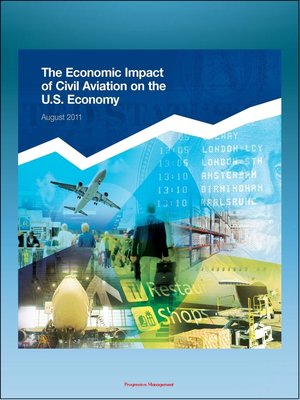The Economic Impact of Civil Aviation on the U.S. Economy
ebook ∣ FAA Study on Outlook, Measures, GDP Contribution, Passenger Expenditures, Freight Flows, Freight Exports, Domestic Air Freight
By Progressive Management

Sign up to save your library
With an OverDrive account, you can save your favorite libraries for at-a-glance information about availability. Find out more about OverDrive accounts.
Find this title in Libby, the library reading app by OverDrive.



Search for a digital library with this title
Title found at these libraries:
| Loading... |
This official Federal Aviation Administration (FAA) document - converted for accurate flowing-text ebook format reproduction - offers the latest data on the economic impact of civil aviation. This concise report is ideal for policymakers and industry officials. This version contains several new points of analysis including the economic impact of federal spending on aviation and hard-to-quantify economic enablers such as speed, cost, flexibility, reliability and safety. Over the decades, civil aviation has been a catalyst for commerce.In today's ever-changing and innovative world, aviation provides a vital link to economic opportunities at home and abroad. In the wake of global economic and financial uncertainties, runways have become the new main streets for cities and towns to get down to business and soar once more.In 2009, civil aviation supported over 10 million jobs, contributed $1.3 trillion in total economic activity and accounted for 5.2 percent of total U.S. Gross Domestic Product (GDP). Civilian aircraft engines, equipment and parts also contribute $75 billion toward the U.S. trade balance. Civilian aircraft engines, equipment and parts have been the top net export for the past decade.Our economic success clearly depends on the success of aviation. So the Federal Aviation Administration (FAA) is committed to providing the safest, most efficient aerospace system in the world. As we move forward, the FAA will continue to invest in airports, and build the Next Generation Air Transportation System (NextGen). NextGen is a transformation of the National Airspace System. It will add a suite of 21st century technologies and procedures to make air travel more efficient and green. FAA'S Destination 2025 will provide the strategic bridge to accomplish the NextGen vision.Contents: Overview * Introduction * Economic Impact of Civil Aviation Highlights * Current Outlook * Impact of the Recession on U.S. Airlines, Coping Strategies and Future Outlook * National Impact of U.S. Civil Aviation * Methodology * Types of Economic Impacts * Measures of Economic Impacts * Update * Results * Aviation's Contribution to Gross Domestic Product * Real Change from the Previous Year 28 Manufacturing * General Aviation * FAA Spending Overview * Enabling Impact * Passenger Expenditures * Freight Flows * Freight Exports * Domestic Air Freight * Conclusion * Appendix - Supplemental Tables * Glossary of Economic Terms






